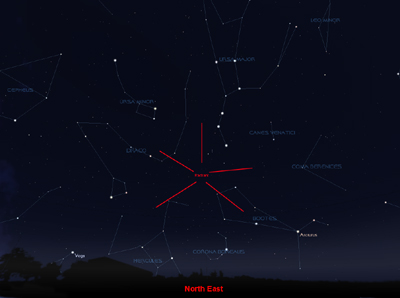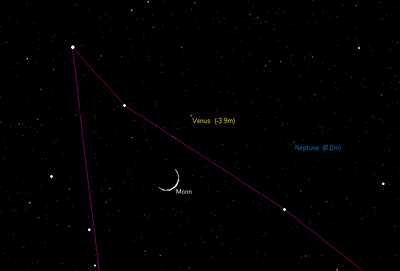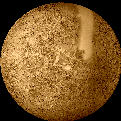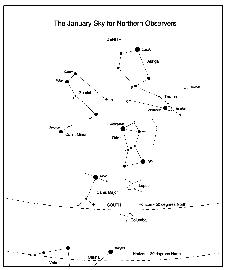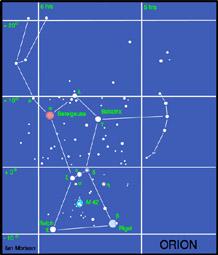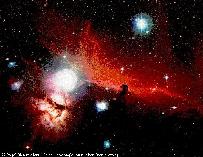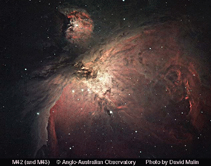The Night Sky January 2007
Compiled by Ian Morison
This page, updated monthly, will let you know some of the things that you can look out for in the night sky. It lists the phases of the Moon, where you will see the naked-eye planets and describes some of the prominent constellations in the night sky during the month.
Image of the Month
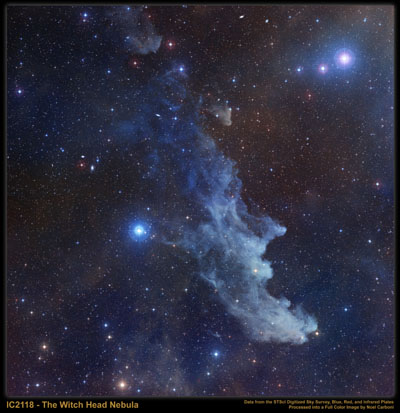
The Witch Head Nebula - click on image to download a full resolution version
Image: Credit and Copyright - Noel Carboni
The Witch Head Nebula
This beautiful image shows the region, called the Witch Head Nebula, close to the bright blue-giant star Rigel which lies just outside the top right of the picture in the constellation Orion. It is more formally know as IC2118 and is called a reflection nebula as it glows primarily by the light reflected from Rigel by small dust particles in the nebula. The blue colour is due, not only to the predominatly blue light emitted by Rigel, but also by the fact that the dust particles reflect blue light more efficiently than red light. Our sky appears blue for a similar reason, but here it is molecules of nitrogen and oxygen that scatter the blue light preferentially.
See more of Noel Carboni' images
The Moon
| new | first quarter | full moon | last quarter |
|---|---|---|---|
| Jan 19th | Jan 25th | Jan 3rd | Jan 11th |
Some Lunar Images by Ian Morison, Jodrell Bank Observatory: Lunar Images
Highlights of the Month
January 4th after midnight: look out for the Quandrantid Meteor Shower - and observe Alcor and Mizar
The Quantrantids
The early morning of Jan 4th will give us the chance, if clear, of observing the Quandrantid meteor shower this year. The radiant - where the meteors appear to come from - is in the constellation Bootes not far below the tail of Ursa Major, the Great Bear. Here there was once a small constellation named after the "Quadrant" which was the device used by early astronomers - most notably Tycho - to measure the elevation of stars as they crossed the meridian (an arc running from horizon, due south, up to the pole star). Given the time at which this happens, it is possible to measure the star's celestial co-ordinates. The peak hourly rate can reach 200, but they are not particularly bright so a good dark observing site will help observe them. Sadly this year, the virtually full Moon will lie high in the south so limiting our observing prospects. Whilst observing this part of the sky look at the central star of the tail of the Great Bear. Binoculars will easily show that there are two stars - Mizar,the brighter and Alcor, the Horse and Rider. You may even spot this with your unaided eye. A small telescope will show that Mizar is a nice double star! If it is clear it will be cold - so wrap up well, wear a woolly hat and have some hot drinks with you!
January 20th:2 - 4 am - The New Moon and Venus
If it is clear just after sunset on the 20th January there would be visible a nice grouping of the New Moon just to the lower left of the planet Venus in the constellation Capricorn. Given a telescope with medium magnification to reduce the light from the setting Sun you may also be able to spot the planet Neptune which is shining at magnitude 8 almost above the nearby star Iota Cap(to the right and just below the full Moon). The chart shows the approximate rectangle made by these four objects in the sky.
The Planets
Jupiter
Jupiter, lying in the constellation Libra, passed behind the Sun during the early part of November but, by the beginning of January, rises at 6 am low in the south-east about 100 minutes before the Sun. As the month continues it will rise earlier - its seperation from the Sun increasing from 32 degrees to 57 degrees and, by months end, will rise nearly 4 hours before the Sun. Jupiter will be a morning object for several months yet. Sadly, Jupiter now lies in Scorpius, along the most southerly part of the ecliptic, and will never reach the high elevations in the sky that we have enjoyed in recent years so our views will be hindered by the atmosphere. A trip to Hawaii would be just the ticket!
Saturn
Saturn is in the constellation Leo and about 5.5 degrees up and to the right of its brightest star Regulus at the start of January. As the month progresses Saturn moves back along the ecliptic - called retrograde motion which is due to the Earth's own motion around the Sun and hence our changing viewpoint - and ends the month about 7.5 degrees from Regulus. It rises in the east north-east at ~ 8:00 pm as January starts and is due south and highest in the sky at ~ 3 am. At January's end it rises at 18:00 and is due south at 1 am in the morning. Its magnitude is ~ +0.2 and its globe subtends an angle of ~20 arc seconds. The rings are closing and are now about 13 degrees from edge-on, so Saturn is shining less brightly than during the previous few years whilst the rings have been more open. Saturn is still, however, a beautiful sight in a small telescope. A 4 to 6 inch telescope will also easily show Saturn's largest moon Titan, and an 8 inch three or four more.
The image was taken as the Cassini spacecraft neared Saturn at the start of its exploration of the planet and its moons - particularly Titan.
Mercury
Mercury passes behind the Sun on January 7th and will thus be lost in the Sun's glare until the last week of January whem it may be glimpsed in the western sky just after Sunset down to the lower right of Venus. It will be at magnitude -1 compared to that of Venus of -3.9 and binoculars will help to pick it out in the twilight.
Note that the blank region in the image above is simply because this part of Mercury's surface has not yet been imaged in detail.
Mars
Mars reappeared in the pre-dawn sky at the very end of November and during December it gradually rose earlier than the Sun so became easier to see. At January's start it lies about two thirds of the way between The Sun and Jupiter and rises about 1 hour before the Sun. It will be at magnitude +1.5, but its disk will be just ~5 arc seconds across so no details will be seen on the salmon pink surface.
Venus
Venus passed behind the Sun on October 27th so, a month or so later, it is now on the eastern side of the Sun, becoming visible after sunset and setting about 1 hour after the Sun. It should be spotted with binoculars in the south-west just after sunset lying 16 degrees away from the Sun at the beginning of January, but this increases to to 23 degrees during the month and so Venus sets later and become easier to spot as the month progresses!
Find more planetary images and details about the Solar System: The Solar System
The Stars
The Stars
The Mid to Late Evening January Sky
This map shows the constellations seen in the south around midnight. The brilliant constellation of Orion is seen in the south. Moving up and to the right - following the line of the three stars of Orion's belt - brings one to Taurus; the head of the bull being outlined by the V-shaped cluster called the Hyades with its eye delineated by the orange red star Aldebaran. Further up to the right lies the Pleaides Cluster. Towards the zenith from Taurus lies the constellation Auriga, whose brightest star Capella will be nearly overhead. To the upper left of Orion lie the heavenly twins, or Gemini, their heads indicated by the two bright stars Castor and Pollux. Down to the lower left of Orion lies the brightest star in the northern sky, Sirius, in the consteallation Canis Major. Finally, up and to the left of Sirius is Procyon in Canis Minor. There is also information about the constellation Ursa Major,seen in the north,in the constellation details below.
The constellation Taurus
Taurus is one of the most beautiful constellations and you can almost imagine the Bull charging down to the left towards Orion. His face is delineated by the "V" shaped cluster of stars called the Hyades, his eye is the red giant star Aldebaran and the tips of his horns are shown by the stars beta and zeta Tauri. Although alpha Tauri, Aldebaran, appears to lie amongst the stars of the Hyades cluster it is, in fact, less than half their distance lying 68 light years away from us. It is around 40 times the diameter of our Sun and 100 times as bright.
To the upper right of Taurus lies the open cluster, M45, the Pleiades. Often called the Seven Sisters, it is one of the brightest and closest open clusters. The Pleiades cluster lies at a distance of 400 light years and contains over 3000 stars. The cluster, which is about 13 light years across, is moving towards the star Betelgeuse in Orion. Surrounding the brightest stars are seen blue reflection nebulae caused by reflected light from many small carbon grains. These relfection nebulae look blue as the dust grains scatter blue light more efficiently than red. The grains form part of a molecular cloud through which the cluster is currently passing. (Or, to be more precise, did 400 years ago!)
Close to the tip of the left hand horn lies the Crab Nebula, also called M1 as it is the first entry of Charles Messier's catalogue of nebulous objects. Lying 6500 light years from the Sun, it is the remains of a giant star that was seen to explode as a supernova in the year 1056. It may just be glimpsed with binoculars on a very clear dark night and a telescope will show it as a misty blur of light.
Its name "The Crab Nebula" was given to it by the Third Earl of Rosse who observed it with the 72 inch reflector at Birr Castle in County Offaly in central Ireland. As shown in the drawing above, it appeared to him rather lile a spider crab. The 72 inch was the world's largest telelescope for many years. At the heart of the Crab Nebula is a neutron star, the result of the collapse of the original star's core. Although only around 20 km in diameter it weighs more than our Sun and is spinning 30 times a second. Its rotating magnetic field generate beams of light and radio waves which sweep across the sky. As a result, a radio telescope will pick up very regular pulses of radiation and the object is thus also known a Pulsar. Its pulses are monitored each day at Jodrell Bank with a 13m radio telescope.
The constellation Orion
Orion, perhaps the most beautiful of constellations, will be seen in the south at around 11 - 12 pm during January. Orion is the hunter holding up a club and shield against the charge of Taurus, the Bull up and to his right. Alpha Orionis, or Betelgeuse, is a read supergiant star varying in size between three and four hundred times that of our Sun. The result is that its brightness varies somewhat. Beta Orionis, or Rigel, is a blue supergiant which, at around 1000 light years distance is about twice as far away as Betelgeuse. It has a 7th magnitude companion. The three stars of Orion's belt lie at a distance of around 1500 light years. Just below the lower left hand star lies a strip of nebulosity against which can be seen a pillar of dust in the shape of the chess-board knight. It is thus called the Horsehead Nebula. It shows up very well photographically but is exceedingly difficult to see visually - even with relativly large telescope.
Beneath the central star of the belt lies Orion's sword containing one of the most beautiful sights in the heavens - The Orion Nebula. It is a region of star formation and the reddish colour seen in photographs comes from Hydrogen excited by ultraviolet emitted from the very hot young stars that make up the Trapesium which is at its heart. The nebula, cradling the trapesium stars, is a beautiful sight in binoculars or, better still, a telescope. To the eye it appears greenish, not red, as the eye is much more sensitive to the green light emitted by ionized oxygen than the reddish glow from the hydrogen atoms.
The constellation Ursa Major
The stars of the Plough, shown linked by the thicker lines in the chart above, form one of the most recognised star patterns in the sky. Also called the Big Dipper, after the soup ladles used by farmer's wives in America to serve soup to the farm workers at lunchtime, it forms part of the Great Bear constellation - not quite so easy to make out! The stars Merak and Dubhe form the pointers which will lead you to the Pole Star, and hence find North. The stars Alcor and Mizar form a naked eye double which repays observation in a small telescope as Mizar is then shown to be an easily resolved double star. A fainter reddish star forms a triangle with Alcor and Mizar.
Ursa Major contains many interesting "deep sky" objects. The brightest, listed in Messier's Catalogue, are shown on the chart, but there are many fainter galaxies in the region too. In the upper right of the constellation are a pair of interacting galaxies M81 and M82 shown in the image below. M82 is undergoing a major burst of star formation and hence called a "starburst galaxy". They can be seen together using a low power eyepiece on a small telescope.
Another, and very beautiful, galaxy is M101 which looks rather like a pinwheel firework, hence its other name the Pinwheel Galaxy. It was discovered in1781 and was a late entry to Messier's calalogue of nebulous objects. It is a type Sc spiral galaxy seen face on which is at a distance of about 24 million light years. Type Sc galaxies have a relativly small nucleus and open spiral arms. With an overall diameter of 170,000 light it is one of the largest spirals known (the Milky Way has a diameter of ~ 130,000 light years).
Though just outside the constellation boundary, M51 lies close to Alkaid, the leftmost star of the Plough. Also called the Whirlpool Galaxy it is being deformed by the passage of the smaller galaxy on the left. This is now gravitationally captured by M51 and the two will eventually merge. M51 lies at a distance of about 37 million light years and was the first galaxy in which spiral arms were seen. It was discovered by Charles Messier in 1773 and the spiral structure was observed by Lord Rosse in 1845 using the 72" reflector at Birr Castle in Ireland - for many years the largest telescope in the world.
Lying close to Merak is the planetary nebula M97 which is usually called the Owl Nebula due to its resemblance to an owl's face with two large eyes. It was first called this by Lord Rosse who drew it in 1848 - as shown in the image below right. Planetary nebulae ar the remnants of stars similar in size to our Sun. When all possible nuclear fusion processes are complete, the central core collpses down into a "white dwarf" star and the the outer parts of the star are blown off to form the surrounding nebula.



